|
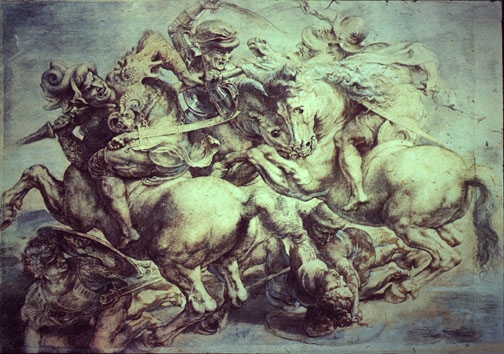
Paint found in the Battle of Anghiari:
- Complex copper carbonate - rare in paintings, but also found in
The Last Supper and a recipe is in the Treatise on Painitng.
- Blue smalt - powdered glass colored by blue cobalt. Same composition
in Madonna of the Rocks (Louvre).
- Azurite - not generally used in fresco, suggest different paint
technologies used.
- Charcoal
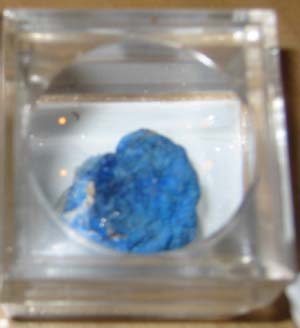
Newton, Travers H., and Spencer, John R., "On the
Location of Leonardo's Battle of Anghiari". Ed. Farago, Claire J.
Leonardo da Vinci: Selected Scholarship. Garland Publishing, Inc. New
York, 1999.
back to top
About Greek Pitch:
Leonardo's receipt for materials include eighty-nine pounds and eight
ounces of Greek pitch, dated April 30, 1505. May have been used as a base
for painting on plaster, three different theories abound:
- Use of Greek pitch to seal the plaster from dampness. Modern painters
use similar substances, such as resin, and paint on a thin clear layer
to protect the surface from acid.
- The Greek pitch can be mixed with other substances, such as linseed
oil and gesso, and used as preparation for oil painting.
- For painting surfaces, when Greek pitch is mixed into plaster,
the mixture provides support on the wall. The result is similar to encaustic
materials.
back to top
Where Leonardo may have failed:
1. Antonion Billi, 1518, suggests that Leonardo had used an oil medium,
whereas
2. Paolo Giovio (1527) relates an unsuccessful combination of walnut
oil and colors on plaster.
3. Anomino Gaddiano, 1540, proposes that Leonardo attempted to bring
back an ancient encaustic method of coloring stucco .
4. Vasari ascribes Leonardo's experimentation on wall preparation beneath
the pigment layer .
And, lastly, heating the vicinity of the painting with a brazier made
the paint drip, due to general dampness of the paint. According to Kemp,
"the rawness of the linseed oil in Leonardo's painting medium caused
him to dry an experimental panel by lighting a fire and thus spoiling
his final effort on the wall" .
2 Farago. Anomino is quoted with "and from Pliny
he discovered how to color with stucco, but he did not understand it well".
3 Farago. Discussed in Vasari.
4 Farago, Claire J. "Leonardo's Battle of Anghiari" A Study
in the exchange between theory and practice". Ed. Farago, Claire
J. Leonardo da Vinci: Selected Scholarship. Garland Publishing, Inc. New
York, 1999.
back to top
Paint composition in the Renaissance, according to Cennini's The
Craftsman's Handbook:
The Craftman's Handbook is an excellent manual for painter during
the Renaissance. There are clear and detailed explanations from the first
step in drawing to making paint to how to paint. The following are excerpts
from the manual to provide a model in how Renaissance painters made their
paint, what they looked for, and to show the amount of work which went
into each color and painting.
The chosen colors are either colors that we used in our project, or remnants
of colors which were found on Leonardo's paintings (azurite). Orpiment
was especially dear to our hearts, since we were ever fearful of the toxicity
of our yellow pigments.
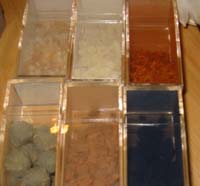 "On the Character of a Red Called Hematite. Chapter XLII. "On the Character of a Red Called Hematite. Chapter XLII.
A color known as hematite is red. This color is natural, and it is a very
strong and solid stone. And it is so solid and perfect tat stones and
crooks are made of it for burnishing gold on panel; and they acquire a
black and perfect color, dark as a diamond. The pure stone is the color
of purple or turnsole, and has a structure like vermilion. Pound this
stone in a bronze mortar at first, because if you broke it upon your porphyry
slab you might crack it [the slab]. And when you have got it pounded,
put on the slab as much of it as you want to work up, and grind it with
clear water; and the more you work it up, the better and more perfect
color it becomes. This color is good on the wall, for working in fresco;
and makes a color for you like a cardinal's, or a purple, or lac color.
It is not good to try to use it for other things, or with temperas."
"On the Character of a Yellow Called Orpiment. Chapter XLVII.
A color known as orpiment is yellow. This color is an artificial one.
It is made by alchemy, and is really poisonous. And in color it is a handsome
yellow more closely resembling gold than any other color. It is not good
for use on a wall, either in fresco or with temperas, because it turns
black on exposure to the air. It is very good for painting on shields
and lances. A mixture of some of this color with Bagdad indigo gives it
a green color for grasses and foliage. Its tempera calls for nothing but
size. Sparrowhawks are physicked [sic] with this color against a certain
illness which affects them. And this color is, to start with, the most
refractory color to work up that there is in our profession. And so, when
you want to work it up, put the amount you want on to your stone; and,
with the one which you hold in your hand, proceed to coax it, little by
little, so as to squeeze it from one stone to the other, mixing in a little
of the glass of a broken goblet, because the powder of the glass attracts
the orpiment to the roughness of the stone. When you have got it powdered,
put some clear water on it, and work it up as much as you can; for if
you were to work it for ten years, it would constantly become more perfect.
Be careful of soiling your mouth with it, lest you suffer personal injury."
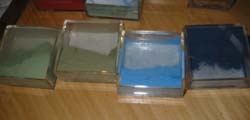
"On the Character of Azurite. Chapter LX.
Natural blue is a natural color which exists in and around the vein of
silver. It occurs extensively in Germany, and also in that…of Siena.
It is quite true…or plastic, it wants to be brought to perfection.
When you have to lay it in, you must work up some of this blue with water,
very moderately and lightly, because it is very scornful of the stone.
If you want it for working on draperies, or for making greens with it
as I have told you above, it ought to be worked up more. This is good
on the wall in secco, and on panel. It is compatible with a tempera of
egg yolk, and of size, and of whatever you wish."
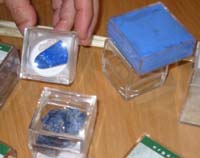 "On the Character of Ultramarine Blue, and How to Make It. Chapter
LXII. "On the Character of Ultramarine Blue, and How to Make It. Chapter
LXII.
Ultramarine blue is a color illustrious, beautiful, and most perfect,
beyond all other colors; one could not say anything about it, or do anything
with it, that is quality would not still surpass. And, because of its
excellence, I want to discuss it at length, and to show you in detail
how it is made. And pay close attention to this, for you will gain great
honor and service from it. And let some of that color, combined with gold,
which adorns all the works of our profession, whether on wall or on panel,
shine forth in every object…"
back to top
Paint techniques learned from the Getty docent:
Linseed oil was first used in Holland, and was popular because it was
an oil that was tacky and would dry well. Linseed oil did remain tacky,
so it was not used in manuscripts. Tobacco oil is similar to Linseed oil,
and is used in paint today as well. Olive oil, on the other hand, would
drip after paint (after 100 years) because it never completely dries.
Before Linseed oil, artists would have to paint each color separately.
Gold was always applied first, because it was pressed on as gold leaf.
A thin layer of gesso was applied, and the leaf was cut into the desired
shape by a knife. Neat, huh?
See the Getty docent, Sheila Harris,
discuss where to find pigments today!
back to top
|









